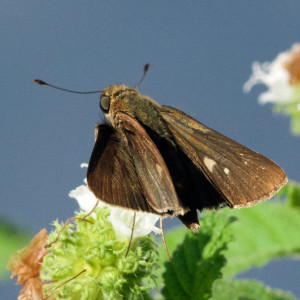That’s right: Ocola, not Ocala. No one seems to know the origin of that name. I assume, although I don’t know, that the “common” name comes from the species name, Panoquina ocola. (I’m having trouble writing this post; the autocorrect keeps trying to change it to either “Ocala” or “cool”; apparently “Ocola” isn’t a word!) My own personal guess is that it’s a corruption of either Ocala or Osceola, both of which are Florida place names that might have flummoxed a young industrialist coal miner from New York.
The coal mine owner who gave the species its name was William Henry Edwards, who named it Hesperia ocola in the Proceedings of the Entomological Society of Philadelphia back in 1863; the range is given as Florida, Georgia, Texas. (In that same article he also described the “Mandan Skipper,” with range given as Lake Winnipeg, just a few miles north of North Dakota, in which state is located the town of Mandan, of Lewis and Clark fame.)
He, together with (and separately from) Samuel Scudder, established American lepidoptera studies in the latter half of the nineteenth century. They were the first to go beyond simple cataloging and taxonomy of the North American butterflies, to include their life histories:
every stage, what the insect ate, its courting and mating behavior, its “parenting” practices, how it dealt with the surrounding world, how it kept going in the face of a grisly army of enemies, and what finally killed it. (Leach 7)
For more on Edwards and his stormy relationship with other nineteenth-century American butterfly enthusiasts, read William Leach’s recent history of American lepidopterists, Butterfly People. Edwards wrote the first comprehensive illustrated guide to North American butterflies by an American, and he spared no expense on the plates; he considered that “nothing is more discouraging to the beginner than dry, unillustrated descriptions” (Leach 18).
With that in mind, I’ll wait no longer to bring you a picture of this migrant to my yard, first time seen after over four years here:

Unlike with most skippers, identification of this one isn’t terribly hard, as long as you get a clear view of the distinctive chevron-shaped mark in the wing. Still, I was reluctant to post this until I got the ID confirmed over at bugguide.net. Randy Emmitt has made an excellent identification page at Butterflies of the Carolinas and Virginias.
While this is a fairly common butterfly, it’s a bit of a local phenomenon. The caterpillars feed on aquatic and semi-aquatic grasses, which I don’t have in abundance anywhere near me. Bugguide lists the following species: Rice (Oryza sativa), Sugarcane (Saccharum officinarum), and Trompetilla Grass (Hymenachne amplexicaulis). So I imagine this is a much more common butterfly out in the western parts of Palm Beach County, where more sugarcane is grown than anywhere else in the continental United States, thanks to a byzantine arrangement of USDA and other government subsidies that allow corporate farmers to sell their product at a price that would be unsustainable on any kind of open market.
But that’s a different story. Me, I’m just writing about a little butterfly that just recently decided to visit my little part of the world. And now I’m done writing about it.
[UPDATE: In my reading about this species in Minno and Minno, I discovered that this grass skipper also uses torpedograss (Panicum repens), which is a very weedy grass that I have growing out front near my lantanas and gumbo limbo; I keep ripping it up, but it has an extremely tenacious and energy-filled rhizome that basically means it’s ineradicable. So maybe there’s a corner of my yard where these Ocola skippers are just enjoying themselves to no end, and I just haven’t found it yet!]
References
Edwards, W. H. 1863. Description of certain species of DIURNAL LEPIDOPTERAN found within the limits of the United States and British America. No. 1. Proceedings of the Entomological Society of Philadelphia, vol. 2, no.1: 14–22.
Leach, W. 2013. Butterfly People: An American encounter with the beauty of the world. New York: Pantheon.
Minno, M.C. & Minno, M. 1999. Florida Butterfly Gardening. Gainesville: UP of Florida.
